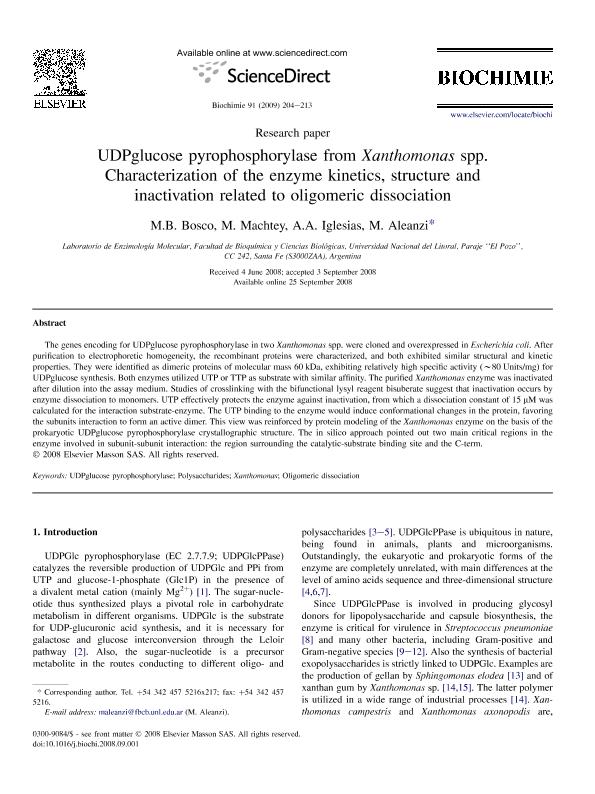Artículo
UDPglucose pyrophosphorylase from Xanthomonas spp. Characterization of the enzyme kinetics, structure and inactivation related to oligomeric dissociation
Fecha de publicación:
02/2009
Editorial:
Elsevier France-editions Scientifiques Medicales Elsevier
Revista:
Biochimie
ISSN:
0300-9084
Idioma:
Inglés
Tipo de recurso:
Artículo publicado
Clasificación temática:
Resumen
The genes encoding for UDPglucose pyrophosphorylase in two Xanthomonas spp. were cloned and overexpressed in Escherichia coli. After purification to electrophoretic homogeneity, the recombinant proteins were characterized, and both exhibited similar structural and kinetic properties. They were identified as dimeric proteins of molecular mass 60 kDa, exhibiting relatively high specific activity (∼80 Units/mg) for UDPglucose synthesis. Both enzymes utilized UTP or TTP as substrate with similar affinity. The purified Xanthomonas enzyme was inactivated after dilution into the assay medium. Studies of crosslinking with the bifunctional lysyl reagent bisuberate suggest that inactivation occurs by enzyme dissociation to monomers. UTP effectively protects the enzyme against inactivation, from which a dissociation constant of 15 μM was calculated for the interaction substrate-enzyme. The UTP binding to the enzyme would induce conformational changes in the protein, favoring the subunits interaction to form an active dimer. This view was reinforced by protein modeling of the Xanthomonas enzyme on the basis of the prokaryotic UDPglucose pyrophosphorylase crystallographic structure. The in silico approach pointed out two main critical regions in the enzyme involved in subunit-subunit interaction: the region surrounding the catalytic-substrate binding site and the C-term. © 2008 Elsevier Masson SAS. All rights reserved.
Archivos asociados
Licencia
Identificadores
Colecciones
Articulos(IAL)
Articulos de INSTITUTO DE AGROBIOTECNOLOGIA DEL LITORAL
Articulos de INSTITUTO DE AGROBIOTECNOLOGIA DEL LITORAL
Citación
Bosco, Maria Belen; Machtey, Matías; Iglesias, Alberto Alvaro; Aleanzi, Mabel Cristina; UDPglucose pyrophosphorylase from Xanthomonas spp. Characterization of the enzyme kinetics, structure and inactivation related to oligomeric dissociation; Elsevier France-editions Scientifiques Medicales Elsevier; Biochimie; 91; 2; 2-2009; 204-213
Compartir
Altmétricas




